By Ronald and Barbara Davis /
Art and Technology: Getting “Pixeldust” From There to Here
“Pixeldust” is my conceptual term for many recent pictures, which I create on Macintosh computers using 3D rendering and graphics software. Pixeldust refers to the elements of a digital image that can be transported at the speed of light across the internet and projected into the universe – or fused onto metal, glass, or paper.
I’ve worked in several different art forms over the decades. But my fascination with digital media began in the late 1970s. I started using computers quite a bit in the 1980s, at first to aid in designing and sketching paintings. In 1988, I discovered three-dimensional rendering software programs that further aided my work.¹ And from the 1990s to the present, I’ve continued to use improved 3D software² and more powerful computers to create entire series of digital renderings.
Beginning with these digital creative tools, I snag a photon’s mass (a particle of light energy) and ultimately convert it into a molecule of digital pigment (a pixel, or grain of “pixeldust”) which, with millions of others, is composed and rendered into a picture. From there, the picture can be output with mass (physical “dust,” such as ink) in a composition and transferred to a physical substrate (paper or metal), where the original color purity, saturation, and gamut are preserved. Or it can be viewed on digital screens of any size. The resulting pictures are not photographs or reproductions; they are original works.
Like all art, “Pixeldust” paintings are achieved by employing technology. Computer technology has allowed me to extend what I have done with resin and fiberglass, canvas and paint. Technology, whether ancient or modern, is a way to “get from here to there” – to make art happen. “Pixeldust” is no different: it starts with wires, transistors, a mouse, software, and wifi. For earlier paintings, I manually arrived at my geometric calculations the old-fashioned way using rulers, string, compass and protractor, slide rule, and a proportion wheel.
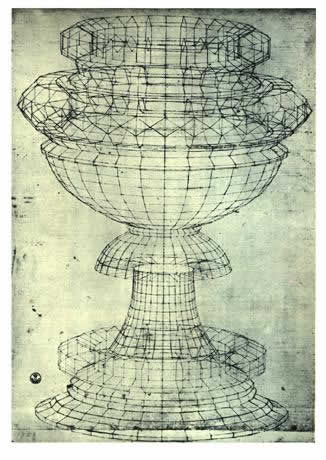
Perspective drawing of chalice ca. 1400s by Paolo Uccello.
But before embracing computers and software, when I was a student at the San Francisco Art Institute in the early 1960s I became fascinated with the Renaissance artist Paolo Uccello, who was himself fascinated with perspective and its use in depicting objects. At SFAI, a course in perspective was not in the curriculum; so I taught myself, and eventually stumbled into a style of painting that can excavate walls and shift the point of view of the viewer: perspective illusion, which is what 3D rendering programs are all about.
If I’ve made any contribution at all, it is that I countered the glacial movement of serious twentieth century painting since Cezanne towards flatness by reintroducing the theorems of three-dimensional Renaissance mathematical perspective into my made objects.
It was this creative intention that sparked my interest in the proposed “Art and Technology” exhibition conceived by Maurice Tuchman of LACMA (Los Angeles County Museum of Art) in the late 1960s and early 1970s. The goal of the project was to bring artists and tech companies together to develop advanced technologies. Artists were invited to suggest what we envisioned or needed from various technological companies in order to create art using new hardware and software. Tuchman and his team hoped this would lead to a contribution to the development of digital art and design. See the archived 1971 catalog.
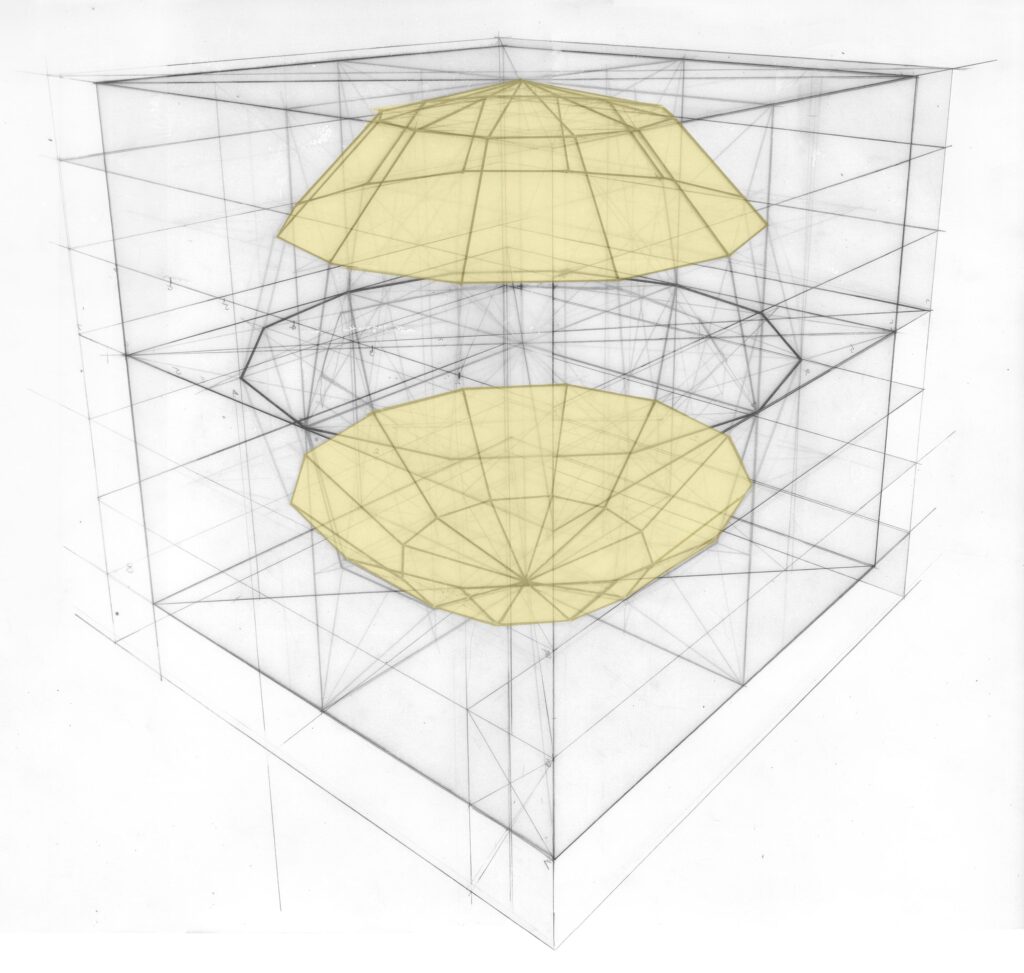
Ronald Davis, hand-drawn shapes in perspective. Pencil and ink on mylar, 1975. 20 x 20 inches. Scaled up and used as templates.
This was exciting stuff. I was introduced by Tuchman’s co-curator Jan Butterfield to the lab-coat technicians and programmers at CalComp Technology, a developer and manufacturer of plotters, scanners, and various digitizers in Anaheim, California. Jan’s job was to match up artists with manufacturing corporations, and she was my contact and go-between for a possible match. For months, she and I drove back and forth to Anaheim where we tried to initiate a steady relationship with CalComp.
Getting to see the CalComp mainframe lab setup was impressive. It could have been a set for a 50’s sci-fi movie, with huge room-sized computer units containing dozens of one-inch tape drives whirring round and round. They wouldn’t let me touch anything, though — the all-male crew of guys in white IBM lab coats were behind a glass wall, writing in Fortran. They asked if I knew Fortran, and when I asked “What’s that?” they looked at me like I was an unexpected fatal data error, and dismissed me – presumably because I was not a programmer.
Tuchman’s plan was to “bring together the incredible resources and advanced technology of industry with equally incredible imagination and talent of the best artists at work today.” (NYT, 1971)
Still, they continued to talk with Jan and me. I had some ideas for the project, and asked one of the programmers if he could do rotations of a depicted object, essentially manipulating a POV perspective drawing (cartoon) from my Dodecagon Series on one of their big plotters connected to the IBM 360 mainframes. The programmer said “Sure! Give us a couple of weeks.”
Jan and I drove down to Anaheim again when the two weeks were up. They presented me with a wide, tractor-feed sheet printed with three views of my concept, one of which was a 12-sided bird’s-eye view of a dodecagon (12-angled polygon) with many concentric dodecagons nested within it, vanishing into the center. There were also perspective views of the dodecagon shapes. It all looked promising to me, because it’s difficult to manually rotate an ink drawing’s subject matter. It would have taken me hours and hours to re-draw an object from another point of view! Therefore, I hoped they would soon program the software to rotate things in perspective, in real time.
My next question upon viewing the printout was “Can we fill in the shapes so all the lines don’t show?” which referred to the “hidden line problem” of filling-in wireframe section paths to be opaque, or to have a pattern of cross-hatch fill to denote shading – a problem graphic programmers were already working on at the time. They said they’d get back to me on that.
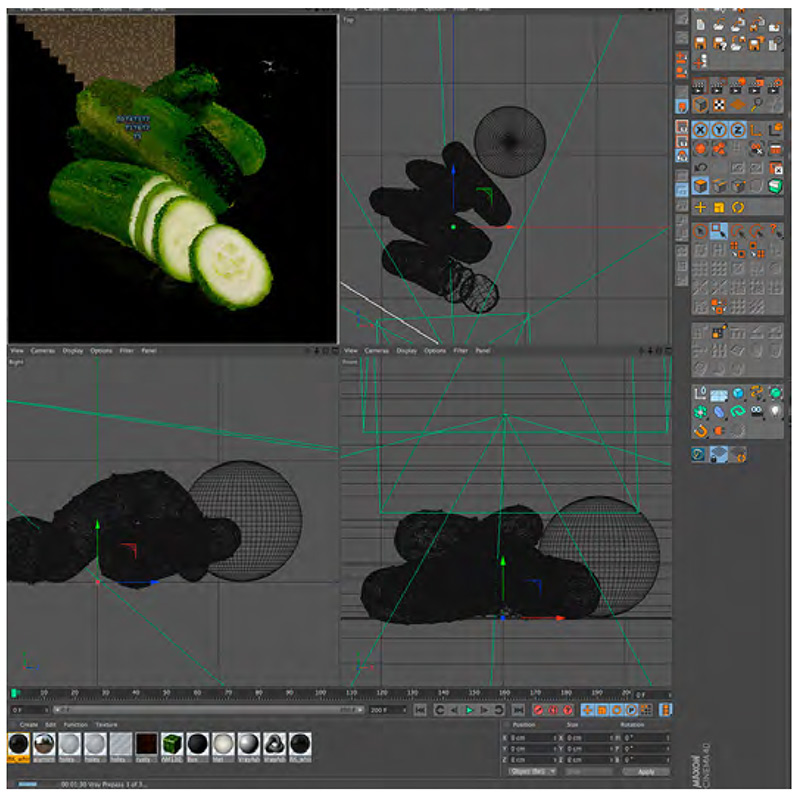
An image can be viewed in various positions and states on a 3D program’s working stage.
My interchange with CalComp stalled, and I was pretty heartbroken, having driven down to the lab all those times only to come up against an early venture capitalist chewing on his cigar, waving it around in front of a whiteboard. I was supposed to draw something – my concept of objects in perspective – on the board for them the way a technician would do. But that wasn’t exciting enough for them.
The guy with the cigar later said, “Why should we be doing this with you?” I suggested “It would be good to have your plotter set up at LACMA, executing these drawings in real time, because nobody has ever seen this technology.” But he was still not interested. Disappointingly, I never got to see the print again; apparently, the museum kept it.
Technology, whether ancient or modern, is a way to “get from here to there” – to make art happen.
Hoping to try again to reach some relationship with CalComp, Jan Butterfield asked Jef Raskin if he could work with me. She and I drove once more to CalComp to meet with Jef. I knew who he was, and thanks to Jan’s introduction, I felt fortunate to meet him. Jef Raskin was the true father of the Macintosh computer ca. 1978.³
Jef looked at the situation with CalComp and remarked, “There’s an easy solution. Just put a dumb terminal in your studio. Jump in! It doesn’t have to be behind glass at IBM. They can install the terminal and you can do it in the middle of the night.” The idea was that I could learn to do this too, and work from my studio.
However, CalComp refused to pay for a Watts line and dumb terminal to my studio, and our collaboration fizzled out. They had grander goals; they made things for Boeing, big important devices, and had little patience for scruffy artists. For example, there was a participating poet/artist who was dismissed from CalComp because the Lab Coats said he “smelled bad and looked untidy.” I guess they didn’t want a smelly poet touching that mainframe.
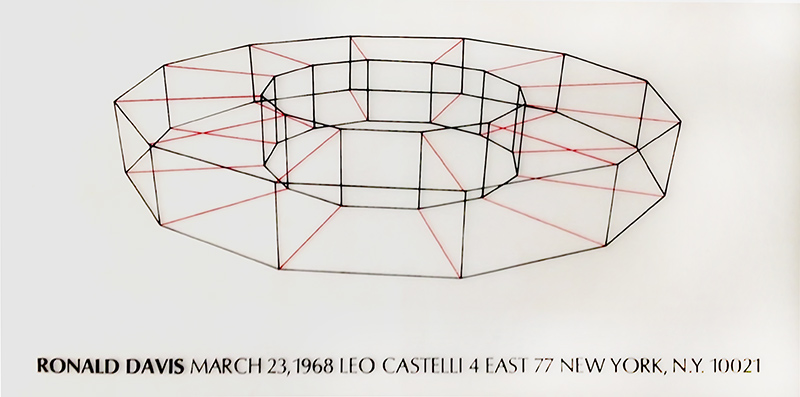
Hand-drawn perspective wireframe view of a Dodecagon, featured on the announcement for the 1968 Drawing exhibition at Leo Castelli Gallery in NYC
In spite of the mismatch between the 1970s programmer technicians and me, I was determined to find my own way. I bought my first Apple computers in the 1980s and became a power user, at the same time learning electronic music programming on beautiful early Buchla⁴ synthesizers. I developed my understanding of digital 3D applications and never stopped learning. As the twentieth century closed out, my ongoing fascination with digital media and geometry kept growing, as did advancements in software and hardware, resulting in the production of many Pixeldust paintings in the 2000s, 2010s, and 2020s. In March 2023 I upgraded hardware and my 3D rendering applications, and have been studying new modules and features. After the pandemic, we needed to make some money, so we started an online affordable print store featuring recent digital artworks for sale.
I’m going to keep at it – it’s not over until it’s over.
- “Graforth” software on an Apple ][e computer
- “VIDI Presenter Pro 3D” software from mid 1980s to late 1990s, for which I was a beta tester. Other 3D software, leading up to current versions of Maxon’s “Cinema 4D,” include “Form•Z”
- Jef Raskin and I talked and hung out a bit, drove down to CaComp together, and visited at my studio a few times. Jef was an impressive guy. He was Employee #31 at Apple Computer, and was instrumental in the GUI design (graphical user interface) of the 1984 Macintosh. A UC Santa Barbara professor turned computer consultant, he was also a programmer, a philosopher, a musician, and an artist with artworks in LACMA. He was also the author of “The Book Of Macintosh,” now a classic.
- Genius instrument-builder Don Buchla said very seriously to me during a tutoring session on my first Buchla 400 analog synthesizer: “You have to learn to count in hexadecimal code to work with the MARF – multiple arbitrary function generator – using eight fingers, two thumbs, and six toes.” (Turns out he was joking, but I bought it for a second.) The Buchla 400 was a hybrid: it had early digital processors that drove the analog synthesizer modules that make musical sounds. Working with the 400 led to the transfer of my fledgling knowledge of computers into aptitude with the early Apple ][, on which I made my first digital images.
_____________________________
MORE…
Cones And Tetrahedron Eve
Cones And Tetrahedron Eve was one of the first computer-aided paintings I made, using a sketch that I drew on my Apple ][e computer. I used a very low power opaque projector to transfer it to the canvas, and much of the painting was painted in the dark. It was included in the book Digital Visions, by Cynthia Goodman, and was shown in a number of museums as an example of “Computer Art,” including the IBM Gallery in NYC.
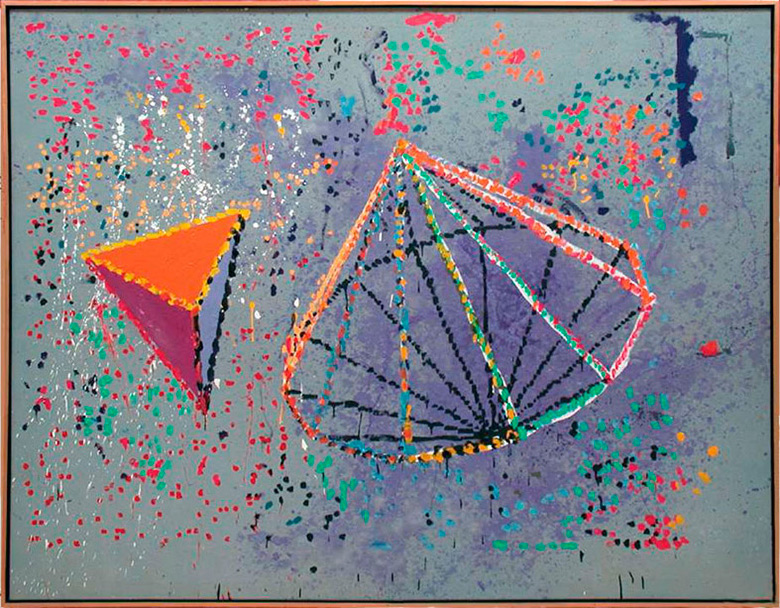
Ronald Davis, Cones and Tetrahedron Eve, 1983. 67 1/2 x 86 1/4 inches
This painting is from a series based on computer-generated imagery. To recreate the image on the computer screen, Davis used an opaque viewer that could project the compositions onto canvas, then he painted them. As early as 1968, when he submitted a proposal to the [Los Angeles County Museum’s] Art and Technology project, Davis was interested in using computers to help him design geometric [3-D] configerations for his paintings. Hardware: Apple ][e computer with 64 K of Ram Memory. Software: Graforth.
Above caption is reprinted from the book by Cynthia Goodman, Digital Visions, 1987, Harry N. Abrams, Inc., Publishers, NYC; Everson Museum of Art, Syracuse, NY.
_____________________________
From the 1971 Art And Technology exhibition catalog
“Ron Davis originally spoke with Hal Glicksman in the Spring of 1969 about doing a project for A & T. Davis was intrigued with the possibility of using computers to assist him in plotting complicated geometric figures, of the kind he has used for several years in his resin paintings. Largely because of Davis’ interest in this project, we spent considerable time and effort negotiating with California Computer Products, Inc., in an attempt to solicit their participation. (Cal Comp had been visited in early April by Eduardo Paolozzi.) In May, HG arranged for the corporation to make for the artist a sample computer drawing of a complex geometric shape, identical to a configuration used in one of the artist’s recent works, showing it in various positions, which demonstrated the principle Davis could employ in using computers himself. We were optimistic about consummating an agreement, but the corporation was reluctant to commit the extent of computer and programming time necessary for the artist’s needs. In July, Davis visited the corporation’s Anaheim facility and saw several demonstrations of computer graphic output. About a month after that meeting, when Cal Comp had still not signed a contract with us, we asked Jeff Raskin to consult with Davis and the Cal Comp people about the project. Raskin visited the company with the artist, and suggested that they make available to Davis a console which he could operate from his own studio. This suggestion was apparently not regarded as feasible by the corporation, and finally they indicated to us their decision to decline any commitment.”
From the archived online catalog: A report on the Art and Technology Program of the Los Angeles County Museum of Art, 1967-1971, by Los Angeles County Museum of Art, Art and Technology Program, 1971
_____________________________
For further looking and reading:
Buy affordable Ronald Davis prints!
Review of the 1971 Art and Technology exhibition by Art News
“Report on Art and Technology,” LA County Museum of Art
Review of Ronald’s Pixeldust paintings by Richard Tobin, Harwood Museum of Art, Taos, NM

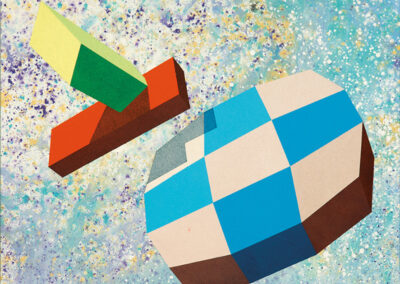
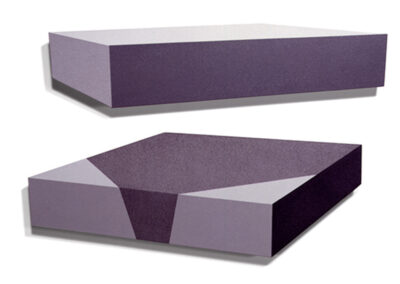
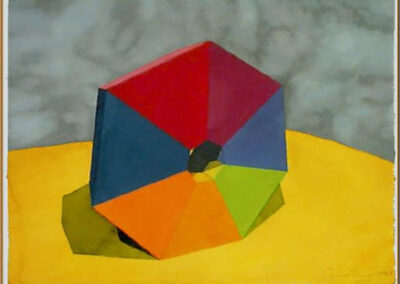
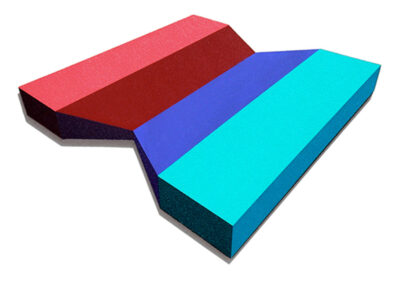
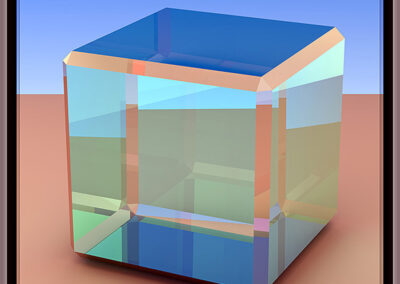
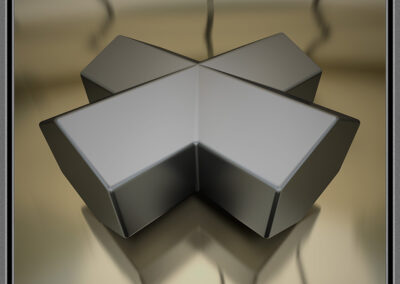
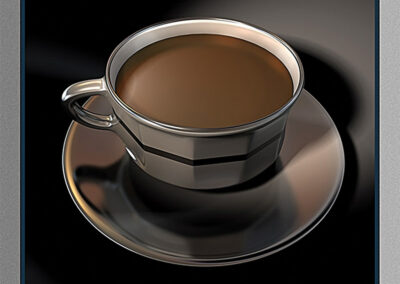
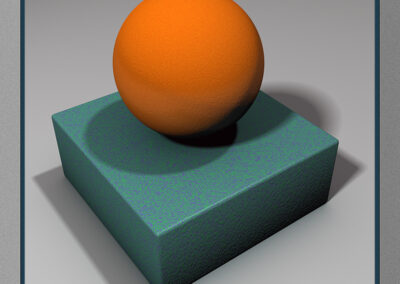
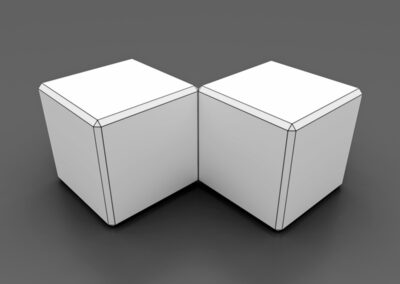
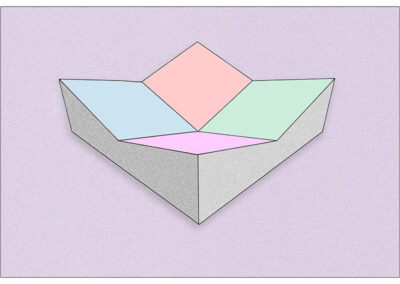
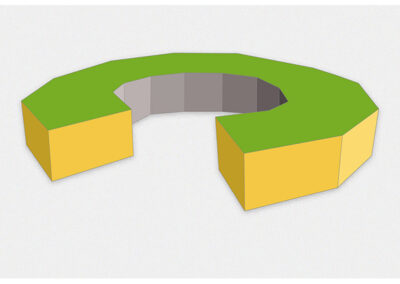
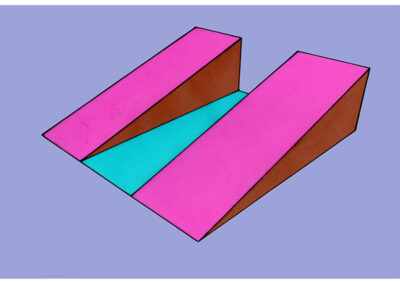
I’m sorry those IBM tech guys in their white lab coats gave you the stink eye!